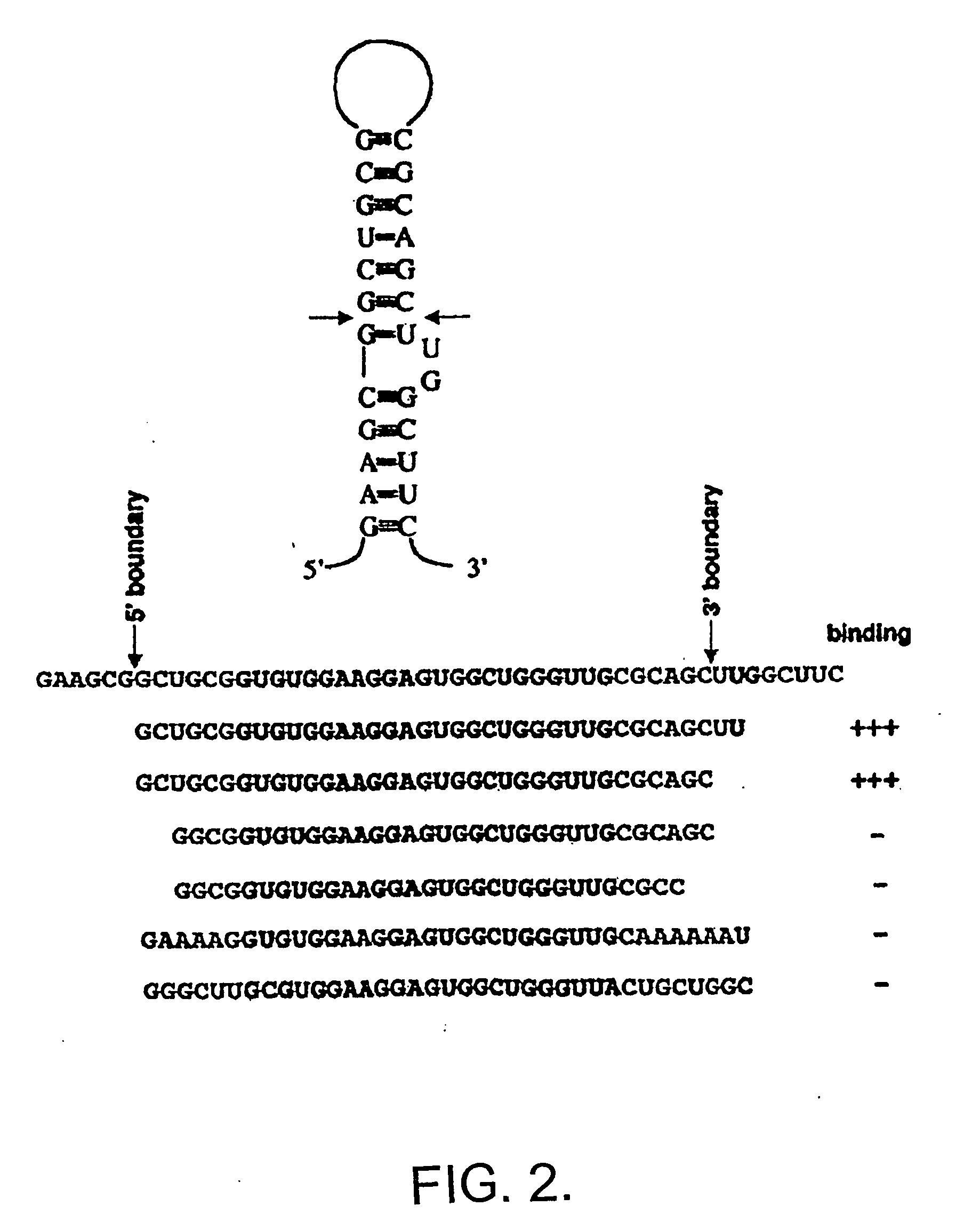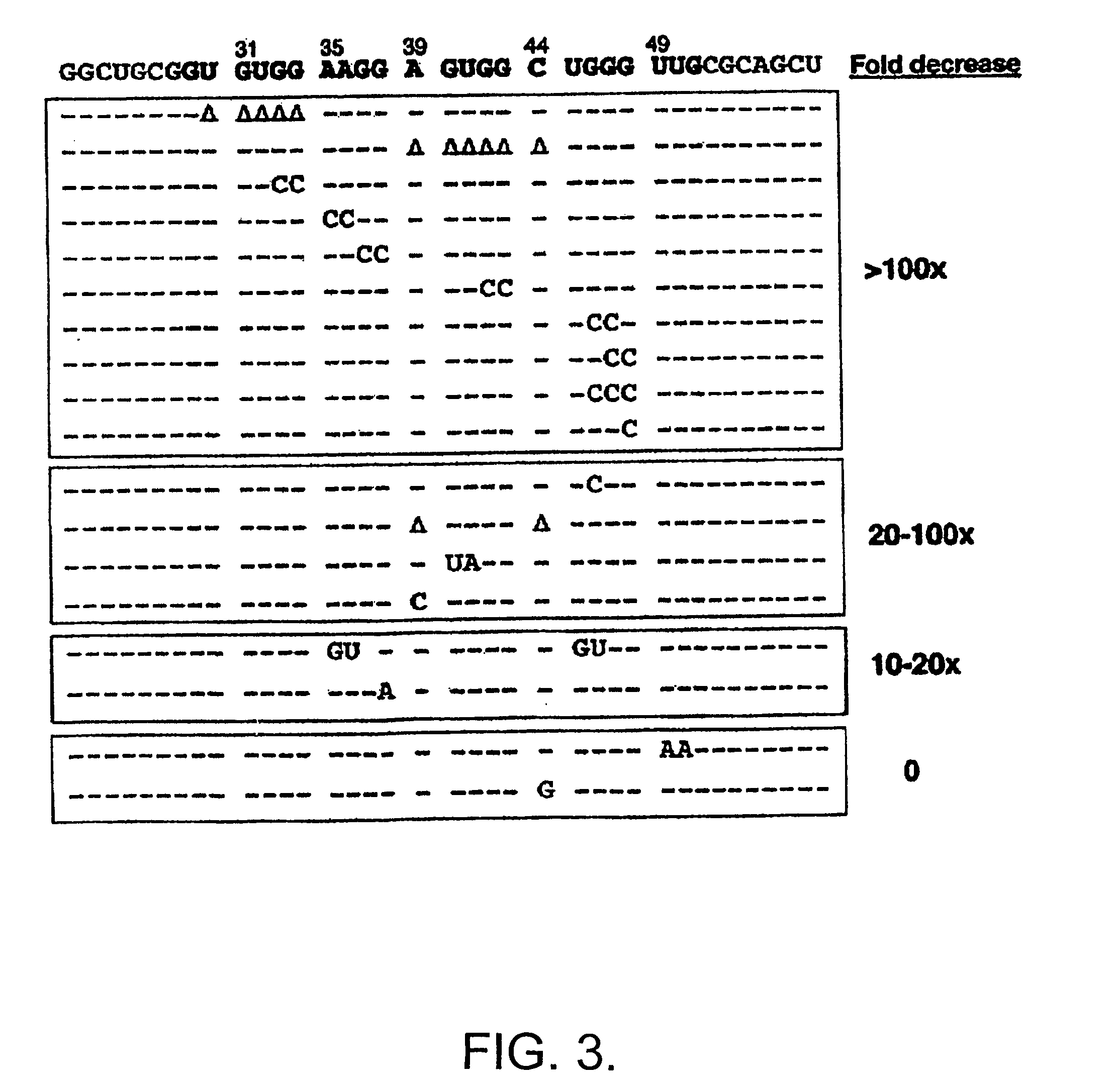Method and identification of downstream mrna ligands to fmrp and their role in fragile x syndrome and associated disorders
a technology of mrna ligands and mrna ligands, which is applied in the field of method and identification of downstream mrna ligands to fmrp and their role in fragile x syndrome and associated disorders, can solve the problems of cognitive deficits, severe fragile x phenotype, and little success in identifying the particular rnas or mrnas to which fmrp binds
- Summary
- Abstract
- Description
- Claims
- Application Information
AI Technical Summary
Benefits of technology
Problems solved by technology
Method used
Image
Examples
example 1
In vitro RNA Selection with FMRP
[0063] Baculoviral histidine-tagged FMRP was purified by sequential metal-chelating and polyribo-G affinity chromatographies (not shown). This FMRP was bound to a nickel-Sepharose column and used to bind a pool of 32P-UTP labeled 96-mer RNAs containing 52 bases of random sequence. FMRP was eluted with imidazole and co-eluting RNAs were pooled, amplified by reverse transcription-PCR, and retranscribed for subsequent RNA selection. Clones were sequenced following the 7th-9th rounds of selection.
[0064] Sequencing 39 clones from the 8th and 9th rounds revealed only 6 different species of cDNA, and by the 9 th round two of the 6 clones made up 75% of the pool. Round nine clones contained 5 unique sequences, whose frequency varied from 1 / 24 to 9 / 24 (not shown, sc1-5), and round eight contained one additional clone (sc6). Examination of these six sequences revealed a common sequence motif of DWGG-N(0-2)-DWGG-N(0-1)-DWGG-N(0-1)-DWGG (FIG. 1).
[0065] In ord...
example 2
Identification of the FMRP Domain that Binds the sc1 G-Quartet
[0075] In order to determine the domains of FMRP responsible for binding to sc1 the I304N mutation in the KH2 domain was generated and the equivalent mutation in the KH1 domain of full-length FMRP was generated, singly or in combination. These mutant proteins bound sc1 nearly as well as wild-type FMRP, suggesting that sc1 RNA binds FMRP in a KH domain-independent manner (not shown). Testing the isolated N- and C-termini of FMRP revealed that all the sc1 binding activity is in the C-terminal domain of FMRP, distal to the KH domains (not shown).
[0076] Deletions of the C-terminus were produced in the pET system and assayed for sc1 binding (not shown). Assessment of a series of mutant proteins revealed that the RGG box alone had an affinity of 10 nM for sc1 RNA, which was indistinguishable from the affinity of full-length FMRP. Because RGG boxes have been suggested to be nonspecific RNA-binding domains, RGG binding to a nu...
example 3
FMRP RNA Targets Predicted from RNA Selection
[0079] mRNA transcripts that might be bound by FMRP were identified by searching UniGene for the G-quartet consensus sequence surrounded by a 6-bp stem within four nucleotides of the DWGG elements using RNABob, a program capable of searching for both structural and sequence-specific elements (see www.genetics.wustil.edu / eddy / software; Gautheret et al. (1990) Comput. Appl. Biosci. 6:321-331). RNABob predicted 71 FMRP binding sites from the UniGene database. These sequences were folded by mfold version 3.1 (Matthews et al. (1999) J. Mol. Biol. 288:911-940) and those sequences that had competing internal stems were discarded. Of the 31 remaining targets likely to fold into G-quartets, 12 were assayed for FMRP binding (Table 1, below). Of these 12 candidates, 6 bound to FMRP with affinities ranging from Kd 75 nM to 467 nM, while 6 did not bind (Kd>1.2 μM).
TABLE 1FMRP RNA TargetsAlter-ation inLocationFra(X)GenBankKdofGPoly-AccessionmRNAnMT...
PUM
| Property | Measurement | Unit |
|---|---|---|
| pH | aaaaa | aaaaa |
| pH | aaaaa | aaaaa |
| pH | aaaaa | aaaaa |
Abstract
Description
Claims
Application Information
 Login to View More
Login to View More - R&D
- Intellectual Property
- Life Sciences
- Materials
- Tech Scout
- Unparalleled Data Quality
- Higher Quality Content
- 60% Fewer Hallucinations
Browse by: Latest US Patents, China's latest patents, Technical Efficacy Thesaurus, Application Domain, Technology Topic, Popular Technical Reports.
© 2025 PatSnap. All rights reserved.Legal|Privacy policy|Modern Slavery Act Transparency Statement|Sitemap|About US| Contact US: help@patsnap.com



